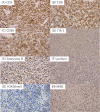Surface CD3-negative monomorphic epitheliotropic intestinal T-cell lymphoma
- PMID: 35979577
- PMCID: PMC9635036
- DOI: 10.3960/jslrt.22005
Surface CD3-negative monomorphic epitheliotropic intestinal T-cell lymphoma
Abstract
Intestinal T/NK-cell lymphomas include enteropathy-associated T-cell lymphoma (EATL), monomorphic epitheliotropic intestinal T-cell lymphoma (MEITL), indolent T-cell lymphoproliferative disorders of the GI tract (ITCLPD), extranodal NK/T-cell lymphoma, nasal type (ENKTL), and intestinal T-cell lymphoma NOS (ITCL-NOS). Here we describe a case of surface CD3-negative MEITL. A 63-year-old Japanese female had a tumor located in the conglomerated ileum, which formed multiple mass lesions. The resected tissue showed a diffuse infiltration of monomorphic medium-sized lymphocytes with epitheliotropism. Flowcytometry using a fresh specimen of the tumor revealed positivity for CD7, CD8, CD38, and CD56, but not surface CD3. On immunohistochemistry, the tumor showed positivity for cytoplasmic CD3, CD8, CD56, TIA-1, Granzyme B, and perforin. EBER with in situ hybridization was negative. Moreover, H3K36me3, which is negative in MEITL with SETD2-mutation, was positive. This is an important case of MEITL due to its oncogenesis.
Keywords: flowcytometry; intestinal T/NK-cell lymphoma; monomorphic epitheliotropic intestinal T-cell lymphoma; surface CD3.
Conflict of interest statement
CONFLICT OF INTEREST
The authors have no potential conflicts of interest to declare with respect to the research, authorship, and/or publication of this article.
Figures





Similar articles
-
The spectrum of intestinal mature T- and NK-cell neoplasms in a tertiary center in Taiwan with a high frequency of perforation.Pathol Res Pract. 2022 Dec;240:154184. doi: 10.1016/j.prp.2022.154184. Epub 2022 Oct 20. Pathol Res Pract. 2022. PMID: 36327820
-
Targeted Next-generation Sequencing Reveals a Wide Morphologic and Immunophenotypic Spectrum of Monomorphic Epitheliotropic Intestinal T-Cell Lymphoma.Am J Surg Pathol. 2022 Sep 1;46(9):1207-1218. doi: 10.1097/PAS.0000000000001914. Epub 2022 May 12. Am J Surg Pathol. 2022. PMID: 35551151
-
Multiple lesions of gastrointestinal tract invasion by monomorphic epitheliotropic intestinal T-cell lymphoma, accompanied by duodenal and intestinal enteropathy-like lesions and microscopic lymphocytic proctocolitis: a case series.Diagn Pathol. 2016 Jul 25;11(1):66. doi: 10.1186/s13000-016-0519-x. Diagn Pathol. 2016. PMID: 27457239 Free PMC article.
-
Contemporary approach to the diagnosis and classification of intestinal T-cell lymphomas.Hum Pathol. 2025 Feb;156:105720. doi: 10.1016/j.humpath.2025.105720. Epub 2025 Jan 24. Hum Pathol. 2025. PMID: 39862928 Review.
-
T- and NK-cell lymphoproliferative disorders of the gastrointestinal tract: review and update.Pathology. 2020 Jan;52(1):128-141. doi: 10.1016/j.pathol.2019.10.001. Epub 2019 Nov 11. Pathology. 2020. PMID: 31727264 Review.
Cited by
-
Celiac Disease Deep Learning Image Classification Using Convolutional Neural Networks.J Imaging. 2024 Aug 16;10(8):200. doi: 10.3390/jimaging10080200. J Imaging. 2024. PMID: 39194989 Free PMC article.
References
-
- Chan JKC, Fukayama M. Haematolymphoid tumours of digestive system: Introduction. In : The WHO Classification of Tumours Editorial Board (eds) : Digestive System Tumours. Lyon (France), International Agency for Research on Cancer. 2019; pp. 376-377.
-
- Olszewska-Szopa M, Wróbel T. Gastrointestinal non-Hodgkin lymphomas. Adv Clin Exp Med. 2019; 28: 1119-1124. - PubMed
-
- Jaffe ES, Bhagat G, Chott A, et al. Intestinal T-cell lymphoma. In : The WHO Classification of Tumours Editorial Board (eds) : Digestive System Tumours. Lyon (France), International Agency for Research on Cancer. 2019; pp. 372-380.
-
- Chan JKC, Chan ACL, Cheuk W, et al. Type II enteropathy-associated T-cell lymphoma: a distinct aggressive lymphoma with frequent γδ T-cell receptor expression. Am J Surg Pathol. 2011; 35: 1557-1569. - PubMed
Publication types
MeSH terms
Substances
LinkOut - more resources
Full Text Sources
Research Materials
Miscellaneous

